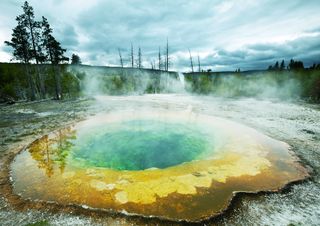Ancestor of All Life on Earth Had Steamy Beginning

The mysterious common ancestor of all life on Earth may have lived in hot springs that were iron-rich and oxygen-poor, a new study finds.
The last universal common ancestor, or LUCA, is what scientists call the forerunner of all living things. Much about LUCA remains uncertain; while previous research suggested that it was little more than a chemical soup from which evolution gradually built more complex forms, recent work suggested it may have been a sophisticated organism with an intricate structure.
To learn more about how and where LUCA might have lived, researchers analyzed 6.1 million genes from prokaryotes — microscopic, single-celled organisms that lack distinct cell nuclei. Bacteria are examples of prokaryotes, while animals, plants and fungi are eukaryotes, or life-forms whose DNA is contained within cell nuclei. Recent findings suggest that prokaryotes are the oldest group of life on Earth, with eukaryotes descending from prokaryotes. [See Photos of the Oldest Organisms on Earth]
The researchers focused on clusters of genes that were found in several different branches of prokaryotes. After figuring out how similar or different the genes were from one another, the researchers developed family trees of these genes. This helped the scientists deduce what genes might be the oldest among prokaryotes, and therefore the ones most likely inherited from LUCA.
The genes the scientists examined were blueprints for proteins. (Some genes are not thought to direct protein-making.) Of the 286,514 protein groups the researchers looked at, only 355 matched the strict criteria that the researchers set for potentially belonging to LUCA. Previous research had uncovered the functions of many of these genes, so they now shed light on LUCA's habitat and lifestyle.
"We can get a glimpse of how and where our most ancient ancestors lived, and these environments are still around today, inhabited by cells whose lifestyle resembles that of LUCA," said study senior author William Martin, a microbiologist at Heinrich Heine University in Düsseldorf, Germany.
LUCA was apparently a thermophile, meaning it thrived at relatively high temperatures. It also was anaerobic, meaning it did not require oxygen for growth. Instead, LUCA apparently lived in an environment rich in hydrogen, carbon dioxide, nitrogen and iron. These sites may also have contained sulfur and selenium.
Sign up for the Live Science daily newsletter now
Get the world’s most fascinating discoveries delivered straight to your inbox.
The scientists concluded that a number of prokaryotes currently alive today dwell in similar settings, namely hydrothermal vents, which include hot springs on land, as well as fissures near undersea volcanoes. These modern prokaryotes include Clostridia bacteria and methanogen archaea.
"It's fascinating to think that some microbes are still living in the same ecological niche where life arose 4 billion years ago," Martin told Live Science.
In the future, "we would like to do some chemical synthesis reactions in the laboratory that simulate ancient hydrothermal vent conditions to see if we can get basic building blocks of life," Martin said.
The scientists detailed their findings online July 25 in the journal Nature Microbiology.
Original article on Live Science.


